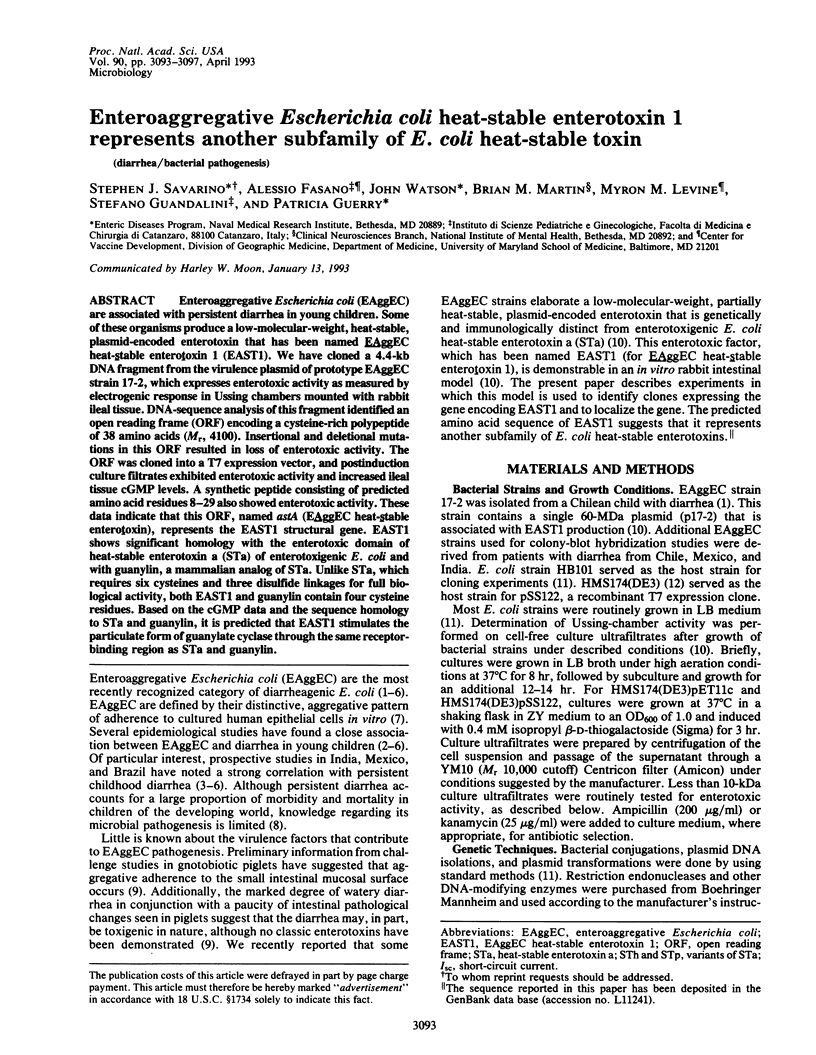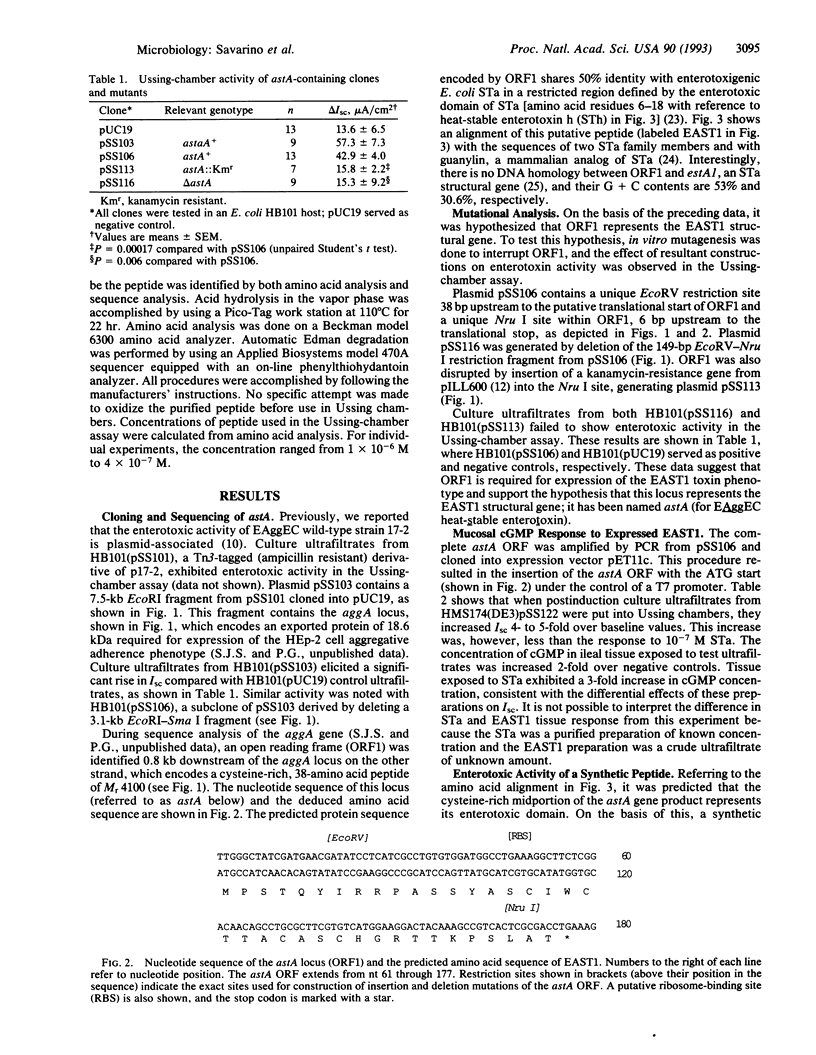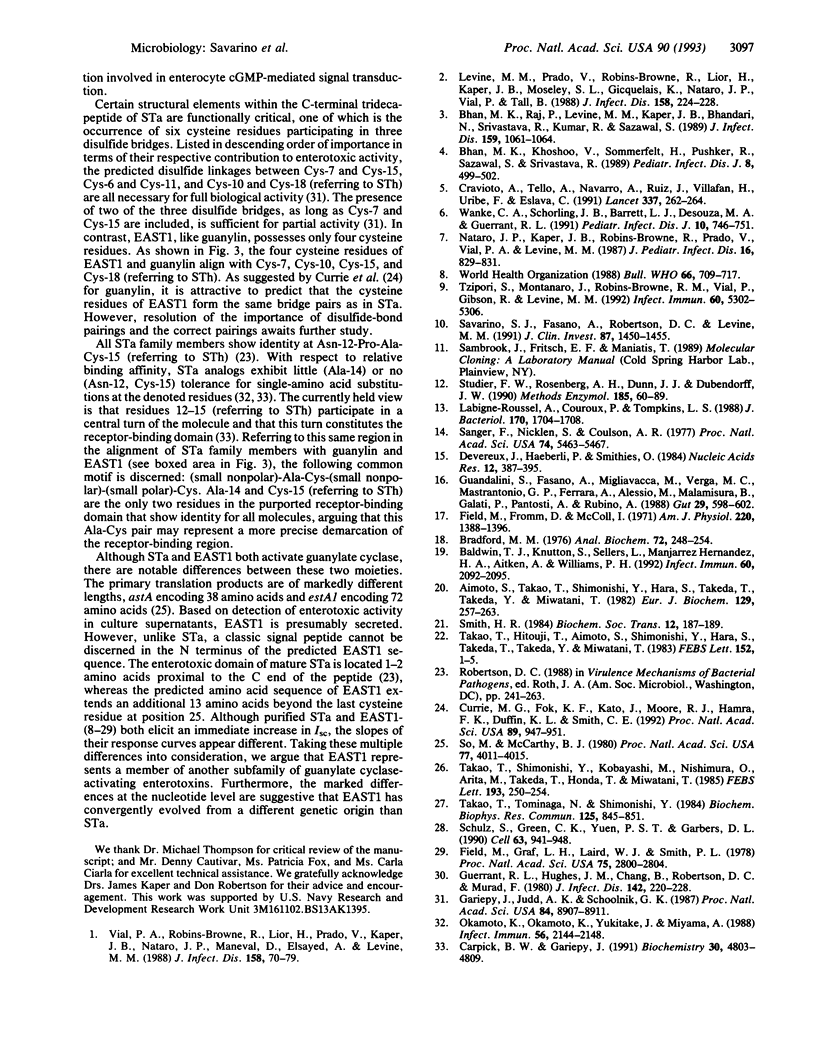Abstract
Enteroaggregative Escherichia coli (EAggEC) are associated with persistent diarrhea in young children. Some of these organisms produce a low-molecular-weight, heat-stable, plasmid-encoded enterotoxin that has been named EAggEC heat-stable enterotoxin 1 (EAST1). We have cloned a 4.4-kb DNA fragment from the virulence plasmid of prototype EAggEC strain 17-2, which expresses enterotoxic activity as measured by electrogenic response in Ussing chambers mounted with rabbit ileal tissue. DNA-sequence analysis of this fragment identified an open reading frame (ORF) encoding a cysteine-rich polypeptide of 38 amino acids (M(r), 4100). Insertional and deletional mutations in this ORF resulted in loss of enterotoxic activity. The ORF was cloned into a T7 expression vector, and postinduction culture filtrates exhibited enterotoxic activity and increased ileal tissue cGMP levels. A synthetic peptide consisting of predicted amino acid residues 8-29 also showed enterotoxic activity. These data indicate that this ORF, named astA (EAggEC heat-stable enterotoxin), represents the EAST1 structural gene. EAST1 shows significant homology with the enterotoxic domain of heat-stable enterotoxin a (STa) of enterotoxigenic E. coli and with guanylin, a mammalian analog of STa. Unlike STa, which requires six cysteines and three disulfide linkages for full biological activity, both EAST1 and guanylin contain four cysteine residues. Based on the cGMP data and the sequence homology to STa and guanylin, it is predicted that EAST1 stimulates the particulate form of guanylate cyclase through the same receptor-binding region as STa and guanylin.
Full text
PDF




Selected References
These references are in PubMed. This may not be the complete list of references from this article.
- Aimoto S., Takao T., Shimonishi Y., Hara S., Takeda T., Takeda Y., Miwatani T. Amino-acid sequence of a heat-stable enterotoxin produced by human enterotoxigenic Escherichia coli. Eur J Biochem. 1982 Dec 15;129(2):257–263. doi: 10.1111/j.1432-1033.1982.tb07047.x. [DOI] [PubMed] [Google Scholar]
- Baldwin T. J., Knutton S., Sellers L., Hernandez H. A., Aitken A., Williams P. H. Enteroaggregative Escherichia coli strains secrete a heat-labile toxin antigenically related to E. coli hemolysin. Infect Immun. 1992 May;60(5):2092–2095. doi: 10.1128/iai.60.5.2092-2095.1992. [DOI] [PMC free article] [PubMed] [Google Scholar]
- Bhan M. K., Khoshoo V., Sommerfelt H., Raj P., Sazawal S., Srivastava R. Enteroaggregative Escherichia coli and Salmonella associated with nondysenteric persistent diarrhea. Pediatr Infect Dis J. 1989 Aug;8(8):499–502. doi: 10.1097/00006454-198908000-00005. [DOI] [PubMed] [Google Scholar]
- Bhan M. K., Raj P., Levine M. M., Kaper J. B., Bhandari N., Srivastava R., Kumar R., Sazawal S. Enteroaggregative Escherichia coli associated with persistent diarrhea in a cohort of rural children in India. J Infect Dis. 1989 Jun;159(6):1061–1064. doi: 10.1093/infdis/159.6.1061. [DOI] [PubMed] [Google Scholar]
- Bradford M. M. A rapid and sensitive method for the quantitation of microgram quantities of protein utilizing the principle of protein-dye binding. Anal Biochem. 1976 May 7;72:248–254. doi: 10.1016/0003-2697(76)90527-3. [DOI] [PubMed] [Google Scholar]
- Carpick B. W., Gariépy J. Structural characterization of functionally important regions of the Escherichia coli heat-stable enterotoxin STIb. Biochemistry. 1991 May 14;30(19):4803–4809. doi: 10.1021/bi00233a023. [DOI] [PubMed] [Google Scholar]
- Cravioto A., Tello A., Navarro A., Ruiz J., Villafán H., Uribe F., Eslava C. Association of Escherichia coli HEp-2 adherence patterns with type and duration of diarrhoea. Lancet. 1991 Feb 2;337(8736):262–264. doi: 10.1016/0140-6736(91)90868-p. [DOI] [PubMed] [Google Scholar]
- Currie M. G., Fok K. F., Kato J., Moore R. J., Hamra F. K., Duffin K. L., Smith C. E. Guanylin: an endogenous activator of intestinal guanylate cyclase. Proc Natl Acad Sci U S A. 1992 Feb 1;89(3):947–951. doi: 10.1073/pnas.89.3.947. [DOI] [PMC free article] [PubMed] [Google Scholar]
- Devereux J., Haeberli P., Smithies O. A comprehensive set of sequence analysis programs for the VAX. Nucleic Acids Res. 1984 Jan 11;12(1 Pt 1):387–395. doi: 10.1093/nar/12.1part1.387. [DOI] [PMC free article] [PubMed] [Google Scholar]
- Field M., Fromm D., McColl I. Ion transport in rabbit ileal mucosa. I. Na and Cl fluxes and short-circuit current. Am J Physiol. 1971 May;220(5):1388–1396. doi: 10.1152/ajplegacy.1971.220.5.1388. [DOI] [PubMed] [Google Scholar]
- Field M., Graf L. H., Jr, Laird W. J., Smith P. L. Heat-stable enterotoxin of Escherichia coli: in vitro effects on guanylate cyclase activity, cyclic GMP concentration, and ion transport in small intestine. Proc Natl Acad Sci U S A. 1978 Jun;75(6):2800–2804. doi: 10.1073/pnas.75.6.2800. [DOI] [PMC free article] [PubMed] [Google Scholar]
- Gariépy J., Judd A. K., Schoolnik G. K. Importance of disulfide bridges in the structure and activity of Escherichia coli enterotoxin ST1b. Proc Natl Acad Sci U S A. 1987 Dec;84(24):8907–8911. doi: 10.1073/pnas.84.24.8907. [DOI] [PMC free article] [PubMed] [Google Scholar]
- Guandalini S., Fasano A., Migliavacca M., Verga M. C., Mastrantonio Gianfrilli P., Ferrara A., Alessio M., Malamisura B., Galati P., Pantosti A. Pathogenesis of postantibiotic diarrhoea caused by Clostridium difficile: an in vitro study in the rabbit intestine. Gut. 1988 May;29(5):598–602. doi: 10.1136/gut.29.5.598. [DOI] [PMC free article] [PubMed] [Google Scholar]
- Guerrant R. L., Hughes J. M., Chang B., Robertson D. C., Murad F. Activation of intestinal guanylate cyclase by heat-stable enterotoxin of Escherichia coli: studies of tissue specificity, potential receptors, and intermediates. J Infect Dis. 1980 Aug;142(2):220–228. doi: 10.1093/infdis/142.2.220. [DOI] [PubMed] [Google Scholar]
- Labigne-Roussel A., Courcoux P., Tompkins L. Gene disruption and replacement as a feasible approach for mutagenesis of Campylobacter jejuni. J Bacteriol. 1988 Apr;170(4):1704–1708. doi: 10.1128/jb.170.4.1704-1708.1988. [DOI] [PMC free article] [PubMed] [Google Scholar]
- Levine M. M., Prado V., Robins-Browne R., Lior H., Kaper J. B., Moseley S. L., Gicquelais K., Nataro J. P., Vial P., Tall B. Use of DNA probes and HEp-2 cell adherence assay to detect diarrheagenic Escherichia coli. J Infect Dis. 1988 Jul;158(1):224–228. doi: 10.1093/infdis/158.1.224. [DOI] [PubMed] [Google Scholar]
- Nataro J. P., Kaper J. B., Robins-Browne R., Prado V., Vial P., Levine M. M. Patterns of adherence of diarrheagenic Escherichia coli to HEp-2 cells. Pediatr Infect Dis J. 1987 Sep;6(9):829–831. doi: 10.1097/00006454-198709000-00008. [DOI] [PubMed] [Google Scholar]
- Okamoto K., Okamoto K., Yukitake J., Miyama A. Reduction of enterotoxic activity of Escherichia coli heat-stable enterotoxin by substitution for an asparagine residue. Infect Immun. 1988 Aug;56(8):2144–2148. doi: 10.1128/iai.56.8.2144-2148.1988. [DOI] [PMC free article] [PubMed] [Google Scholar]
- Sanger F., Nicklen S., Coulson A. R. DNA sequencing with chain-terminating inhibitors. Proc Natl Acad Sci U S A. 1977 Dec;74(12):5463–5467. doi: 10.1073/pnas.74.12.5463. [DOI] [PMC free article] [PubMed] [Google Scholar]
- Savarino S. J., Fasano A., Robertson D. C., Levine M. M. Enteroaggregative Escherichia coli elaborate a heat-stable enterotoxin demonstrable in an in vitro rabbit intestinal model. J Clin Invest. 1991 Apr;87(4):1450–1455. doi: 10.1172/JCI115151. [DOI] [PMC free article] [PubMed] [Google Scholar]
- Schulz S., Green C. K., Yuen P. S., Garbers D. L. Guanylyl cyclase is a heat-stable enterotoxin receptor. Cell. 1990 Nov 30;63(5):941–948. doi: 10.1016/0092-8674(90)90497-3. [DOI] [PubMed] [Google Scholar]
- Smith H. R. Genetics of enterotoxin production in Escherichia coli. Biochem Soc Trans. 1984 Apr;12(2):187–189. doi: 10.1042/bst0120187. [DOI] [PubMed] [Google Scholar]
- So M., McCarthy B. J. Nucleotide sequence of the bacterial transposon Tn1681 encoding a heat-stable (ST) toxin and its identification in enterotoxigenic Escherichia coli strains. Proc Natl Acad Sci U S A. 1980 Jul;77(7):4011–4015. doi: 10.1073/pnas.77.7.4011. [DOI] [PMC free article] [PubMed] [Google Scholar]
- Studier F. W., Rosenberg A. H., Dunn J. J., Dubendorff J. W. Use of T7 RNA polymerase to direct expression of cloned genes. Methods Enzymol. 1990;185:60–89. doi: 10.1016/0076-6879(90)85008-c. [DOI] [PubMed] [Google Scholar]
- Takao T., Hitouji T., Aimoto S., Shimonishi Y., Hara S., Takeda T., Takeda Y., Miwatani T. Amino acid sequence of a heat-stable enterotoxin isolated from enterotoxigenic Escherichia coli strain 18D. FEBS Lett. 1983 Feb 7;152(1):1–5. doi: 10.1016/0014-5793(83)80469-4. [DOI] [PubMed] [Google Scholar]
- Takao T., Shimonishi Y., Kobayashi M., Nishimura O., Arita M., Takeda T., Honda T., Miwatani T. Amino acid sequence of heat-stable enterotoxin produced by Vibrio cholerae non-01. FEBS Lett. 1985 Dec 2;193(2):250–254. doi: 10.1016/0014-5793(85)80163-0. [DOI] [PubMed] [Google Scholar]
- Takao T., Tominaga N., Shimonishi Y., Hara S., Inoue T., Miyama A. Primary structure of heat-stable enterotoxin produced by Yersinia enterocolitica. Biochem Biophys Res Commun. 1984 Dec 28;125(3):845–851. doi: 10.1016/0006-291x(84)91360-3. [DOI] [PubMed] [Google Scholar]
- Tzipori S., Montanaro J., Robins-Browne R. M., Vial P., Gibson R., Levine M. M. Studies with enteroaggregative Escherichia coli in the gnotobiotic piglet gastroenteritis model. Infect Immun. 1992 Dec;60(12):5302–5306. doi: 10.1128/iai.60.12.5302-5306.1992. [DOI] [PMC free article] [PubMed] [Google Scholar]
- Vial P. A., Robins-Browne R., Lior H., Prado V., Kaper J. B., Nataro J. P., Maneval D., Elsayed A., Levine M. M. Characterization of enteroadherent-aggregative Escherichia coli, a putative agent of diarrheal disease. J Infect Dis. 1988 Jul;158(1):70–79. doi: 10.1093/infdis/158.1.70. [DOI] [PubMed] [Google Scholar]
- Wanke C. A., Schorling J. B., Barrett L. J., Desouza M. A., Guerrant R. L. Potential role of adherence traits of Escherichia coli in persistent diarrhea in an urban Brazilian slum. Pediatr Infect Dis J. 1991 Oct;10(10):746–751. doi: 10.1097/00006454-199110000-00006. [DOI] [PubMed] [Google Scholar]


